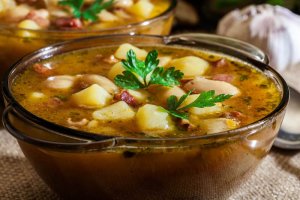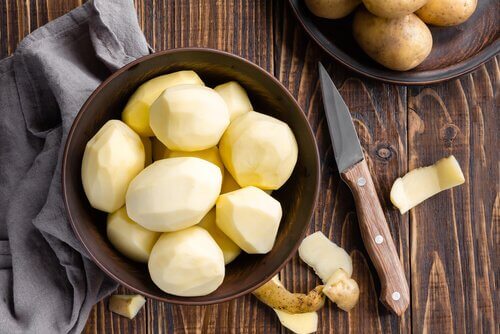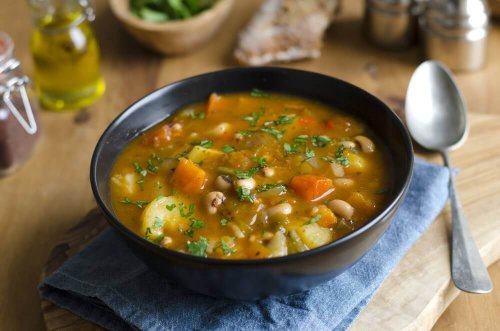How to Make a Delicious Spanish Stew: Pote Gallego

People who are familiar with Spanish stew (or pote gallego) often confuse it at first glance with a caldo, or broth. They do have similar ingredients, but the former is heartier and the latter is made from the leftovers of the pote. It contains a wide variety of vegetables found in gardens all over Galicia.
The original pote gallego isn’t vegetarian, as it’s usually made with meat and bone or animal fat for flavor. The animal fat is called unto, and it comes from the small intestines of the pig. Normally, unto is smoked.
In this recipe, we’ll look at another option.
You may also be interested in this recipe:
Vegetable Omelet Recipe
Traditional pote gallego recipe
Ingredients (for four servings)
- Salt
- 1 blood sausage (morcilla)
- 12 cups of water (3 cups)
- 2 smoked chorizo sausages
- 1/2 kilo of potatoes
- 1 container of broccoli rabe (500 g)
- 1 bunch of collard greens (500 g)
- 2 pork knuckles
- 1 1/4 cup of dried white beans (250 g)
- Piece of pork shoulder (lacón gallego)
- Piece of cured unto (pork fat), preferably yellow (250 g)
Instructions

- Soak the dried white beans overnight, but don’t let them soak for over 8 hours. Then, strain and set aside.
- Add the three liters of water, salt, bones, unto, pork shoulder, and chorizo to a pot and put on medium heat.
- In a separate pot, add the beans along with some water (no salt). Once boiling, quickly strain and add back to the pot with cold water. Repeat the straining and cold water once more before adding the beans to the other pot.
- Cook everything for 30 minutes.
- Wash, peel, and thinly slice the potatoes.
- Wash the broccoli rabe (you’ll just use the leaves, because the stalk can be very hard) and cut up. Rinse with cold water and strain.
- Add the potatoes, broccoli rabe, and collard greens. Let cook another 30 minutes.
A few tips
About the ingredients
- It may be hard to find collard greens out of season. In that case, you can substitute cabbage.
- First, serve the broth, then serve the meat, beans, and lastly the potatoes on top.
- You can add small pieces of veal or other types of red meat as well. White meat is not recommended because it’s not traditional.
- You can also add extra chorizo, blood sausage, and potatoes. It all depends on what you like.
About the seasoning

If you’re careful with how much salt you use and make sure the meat you use isn’t salted, it shouldn’t turn out too salty. However, if it does, add some more water to the pot. Then if that doesn’t work, remove a fourth of the liquid from the pot and then replace with water.
If your meat does come salted, especially the pork shoulder, then you will need to soak it for a few days before making the pote gallego. Change the water out every 12 hours. Still, if you like, you could set one small piece aside to use salted. It will give the stew a strong flavor.
Recommended recipe:
Serving tips
Your pote gallego will have an even better flavor if you let it sit for a few days. So before you serve it, save a bit for leftovers later. Or just make it ahead of time so the flavors have a chance to mix and intensify.
While pote gallego is usually served alone, that doesn’t mean it doesn’t go well with homemade bread. It’s popular in the winter, since it’s served hot, but it’s great all year round as well.
All cited sources were thoroughly reviewed by our team to ensure their quality, reliability, currency, and validity. The bibliography of this article was considered reliable and of academic or scientific accuracy.
- Eladio Rodríguez González, (2000), Diccionario enciclopédico gallego-castellano, Editorial Galaxia, Tomo I, pag. 441
- ↑ Emilia Pardo Bazán, (1913), La cocina española antígua, reed. MAXTOR (2010)
- ↑ Saltar a:a b «Caldo gallego». Gastronomía de Galicia, agencia de turismo de Galicia. 2014. Consultado el 26 de noviembre de 2017.
- ↑ Juan Dantín Cereceda, (1934), La alimentación española: sus diferentes tipos, Madrid, Unión Poligráfica, Primera Pág. 89
- ↑ Cipriano Torre Enciso, (1982), Cocina gallega “enxebre”: así se come y bebe en Galicia, Primera, Editorial Tres-Catorce-Diecisiete, pág 30-36
- ↑ Vila, Miguel (21 de julio de 2011). «Caldo de calabaza». Pequena enciclopedia gastronómica cunqueiriana. Consultado el 26 de noviembre de 2017.
- ↑ «caldo de castañas». Gastronomía de Galicia, agencia de turismo de Galicia. 2014. Consultado el 27 de noviembre de 2017.
- ↑ Juan Neira Cancela, (1889), El caldo gallego, La Coruña, Primera, Biblioteca Gallega
- ↑ Bethan Davies, Ben Cole, (2003), Walking the Camino de Santiago – Pág. 158
This text is provided for informational purposes only and does not replace consultation with a professional. If in doubt, consult your specialist.








